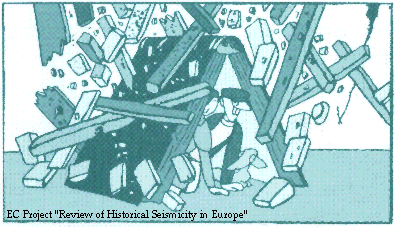
EC project "Review of Historical Seismicity
in Europe" (RHISE) 1989-1993

|
[Deliverables and queries] [Presentation] [Homepage] |
Sources of information
There are a number of earthquake catalogues either for Greece
exclusively (e.g. Papazachos and Papazachos, 1989), or which include data
for the Ionian Islands (e.g. Shebalin et al., 1974). All are to some extent
deficient in that they do not always quote their source of information. To
retrieve data already available in seismological literature, a supplement
of research was devoted to a systematic reading of some of the most significant
seismological compilations of the 19th century for this area, such as for
instance Barbiani (1863), Schmidt (1875), Issel e Agamennone (1893).
In order to provide a context within which can be understood
the macroseismic information which constitute the raw data of our research,
it is necessary to give a brief outline of the historical development of
our study-area during the first half of the 18th century.
During the first half of the 18th century the Ionian Islands were part of
the Republic of Venice, having entered the dominion in different periods
(Lunzi, 1858; Dudan, 1938; Viggiano, 1993). The last was Lefkas (Santa Maura):
conquered by Morosini in 1684, it was abandoned by the Venetians in 1715,
during the last Venetian-Turkish war, and was Venetian again from 1718 to
1797, when the Republic of Venice fell. The continental areas east of the
Ionian Islands (Epirus, Acarnania, and Morea) were under the dominion of
the Ottoman Empire, with the exception of Morea between 1686 and 1718, when
it was part of the Republic of Venice.
Fig. 1 shows some of the most important settlements of the area in that period,
which were the centres from where information on the area was supplied to
the central governments by peripheral officers. Venetian central magistracies
sent governors to administrate the major islands (Corfu, Lefkas, Kefalinia,
Zante), the minor ones (Paxos and Ithaca) as well as the forts on the mainland
(Butrinto, Parga, Préveza, Vonitsa), while consuls were appointed
especially to localities strategically located on the east coast of the Adriatic
Sea - Scutari (Shkodër), Durazzo (Durrës), Arta, Lepanto (Nafpaktos)
and Patras. The localities evidenced inside the Ottoman territory - Delvine,
Yanya (Iannina), Tirhala (Trikala), Inebati (Nafpaktos), and Mizistre (Mistras)
- were the seats of the sanjak (Turkish governors) during the 18th
century.
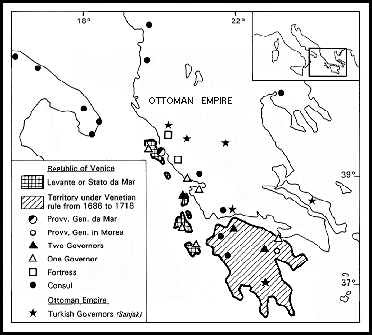
Tab. 1 shows the Venetian documentary sources of information, today available at the State Archives of Venice, and specifically those concerning the Ionian Islands.
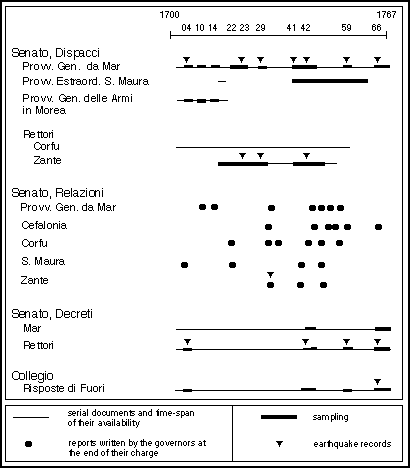
Details are given on the time-span of the documents and the
performed sampling with reference to the case histories discussed below;
therefore, documents on the 1743 earthquake are not shown. Funds and series
with a good temporal continuity of surviving documents are Dispacci
(dispatches), Provveditore Generale da Mar and
Decreti (resolutions) of the Senato. Gaps are more considerable
in those series - Dispacci, Rettori and Relazioni -
collecting documents produced from governors of one island (e.g.
Provveditore Estraordinario of Lefkas) or area (Provveditore Generale
delle Armi in Morea). Such gaps can mainly be attributed to changes in
the administration, as in the case of Lefkas (1715-1718) and Morea (from
1718 on) or dispersion of the documents at the end of a governor's charge
- for instance some personal archives are today kept at the Civico Museo
Correr in Venice (see also Daltri e Albini, 1991). The holdings of the Ionian
Islands archives, which possess a scarce number of files for the period of
interest (Guêze, 1970), cannot fill in those gaps.
Results of the investigation of the fund Cinque Savi alla Mercanzia
were presented in the previous volume (Albini, 1993).
Discussing the case histories, reference will be made to the
data shown in Tab. 1 when the lack of information on earthquake effects from
an island could depend on the fact that no Venetian documents were available
for that island at the time the earthquake occurred. Some of this information
- especially that concerning the 1767 and 1769 earthquakes - has been published
recently by Daltri e Albini (1991), Albini and Daltri (1991), Albini (1993),
Kouskouna et al. (1993).
Our main sources, therefore, are local, first-hand observations
derived from Greek marginal notes, diaries and local histories, from contemporary
Venetian documents, and from coeval reports in the European press and accounts
of travellers. In spite of the proximity of the Ionian Islands to mainland
Greece, very little has been found so far about earthquakes in published
or unpublished Ottoman documents (Ambraseys and Finkel, 1993).
Case histories
In what follows we present the case histories of the events
reappraised in this study. All the earthquakes discussed are documented as
fully as possible on the basis of primary sources. Inevitably, however, there
are cases where the references are omitted when they add no relevant details
or give inaccurate or second hand information.
As many as possible of the sources that have been found to contain information
are referred to in the course of these various accounts when they contribute
value or original material to the seismological aspect of the paper. Any
useful historiographic statements they contain, which may not have been referred
to, on examination may easily be seen in perspective by the reader
himself.
The date of the earthquakes is given both in Old Style (between
parentheses) and in New Style.
1704 November (11) 22
This earthquake happened at 8 p.m. on Saturday 11 November 1704
(O.S.) and caused considerable damage in the north part of the island of
Lefkas (Fig. 2).
A contemporary account written in Lefkas (VVA, cod. 128) says
that:
"On 11 November 1704 [O.S.], Saturday night, which was the day
of St. Minas, at one hour and a half of the night, there happened a terrifying
earthquake in which all stone masonry houses in Amaxiki and a few made of
bricks as well as the churches collapsed; only the church of St. Athanasius,
which was made of timber, survived. Also, at Kastro a few houses collapsed
and the rest were damaged; 13 people were killed at Amaxiki and 3 at Kastro
and others were injured; similarly many houses collapsed in Fryni, and the
earthquake was terrifying throughout the island of Lefkas, where a few
monasteries and many houses in the villages collapsed and in [the church
of] Sta Anastasia at Tsukalades, Athanasoula the wife of Michu Sofrona
was killed; also the cells and bishopric and [the church of] Panagia
in Gyra fell; in particular, a house at Dragano sunk all into the ground
so that only a few stones could be seen; and great destruction was wrought
to the island of Sta Maura [Lefkas]; and after this earthquake there
were many others for many days; and no one had experienced in the past such
a destruction; there fell arcades and hazinades, and similarly at Peratia
many houses collapsed; and the earthquake was felt in Arta, but it was not
as strong as here, and at Korfus [Corfu] and Cefalinia where it was
not so strong".
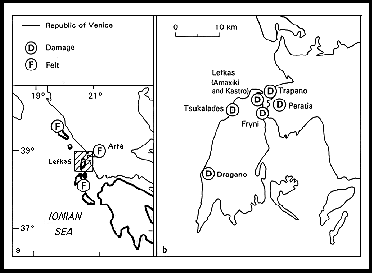
The Provveditore Generale da Mar in his dispatch
of December 6 from Corfu (ASVe, 1704a) confirms that in Lefkas the earthquake
occurred at about one and a half hour of the night on Saturday, 22 November.
The shock damaged the Castle, where four people died, as well as the region
of Amaxiki where 30 people lost their lives. In the Castle the house of the
army commander collapsed and many houses inside and outside the walls, built
of stone masonry, were seriously damaged. The church of Santa Maura was also
ruined (Vladis, 1902). The walls of the Castle were also damaged, the earthquake
adding ten new cracks to the eleven already existing. Also the small fortress
of Trapano, which guarded the narrows between the island and the mainland,
was damaged beyond repair and an engineer was sent from Venice to rebuild
it (ASVe, 1704b). Following the earthquake financial assistance and materials
for the repair and reconstruction were provided by Venice (ASVe, 1705a,
b).
Damage did not extend very far; it was concentrated on the north
part of the island and on the opposite coast of the Greek mainland (VVA,
cod. 128). The earthquake was perceptible in Corfu (Partsch, 1887) where
it did not cause great concern (ASVe, 1704a). Dispatches of that period of
the Venetian governors of Zante and Kefalinia to the magistracy of the
Cinque Savi alla Mercanzia do not mention the earthquake (ASVe, 1693-1722;
ASVe, 1700-1746). Aftershocks continued to be felt well into January 1705
(ASVe, 1704a; Gaceta de Madrid, 1705; Baglivi, 1710).
1710 May 17
From a marginal note, quoted by Barbiani (1863), we learn that
just after midnight on 17 May 1710 (N.S.) a very strong earthquake in Zante
caused the collapse of many buildings and the loss of two lives. There is
no evidence that the shock was felt elsewhere or that it caused undue concern
to the Venetian authorities. The Provveditore Generale da Mar,
who normally lived in Corfu, was at that time in Morea, as it can be deduced
from his dispatches. He was in Zante at least on July 25, when he sent to
the Senato three dispatches (ASVe, 1710). For this period, no dispatches
of the Provveditore of Zante are available (Tab. 1), and this earthquake
is not mentioned in the letters of the same Provveditore to the
Cinque Savi alla Mercanzia (ASVe, 1700-1746).
1714 (August 28) September 8
A damaging earthquake in Kefalinia is mentioned in a 18th century
history of Epirus (Michael, XVIII); it says that after the earthquake in
Patras of 27 July (O.S.)
"... on 28 August [O.S.], another more dreadful earthquake occurred
in Kefalinia, where the Venetian admiral was at anchor with his fleet: the
earth opened, hot water flowed out; 280 houses were destroyed, water issued
from the earth, and the inhabitants lived two months in the
gardens".
So far we could find no mention of this event in the contemporary
dispatches we have examined originating from the Ionian Islands and addressed
to the Venetian authorities (Daltri e Albini, 1991): the Provveditore
Generale da Mar Agostino Sagredo stayed for some time in Morea and
was back in Corfu on 20 August (ASVe, 1714a). He was substituted by Daniele
Dolfin, who visited Kefalinia early in October (ASVe, 1714b). In that period
the attention of the Venetian governors was attracted by the war with the
Ottoman Empire for the control of Morea. There is no mention of this earthquake
(Tab. 1) in the dispatches and letters of the Provveditore of Kefalinia
and of the consul in Patras to the Cinque Savi alla Mercanzia (ASVe,
1693-1722; ASVe, 1712-1764).
The earthquake was reported in the European press where the
events in Patras and Kefalinia are amalgamated into one shock and dated at
3 September 1714 (N.S.) (Theatrum Europaeum, 1714). This erroneous information
is repeated by other contemporary sources (Amato, 1715).
1722 (May 25) June 5
A damaging earthquake in the southwest part of the island of
Lefkas. A Greek marginal note written in Amaxiki says that
"... towards dawn on Thursday 22 May 1722, there were two consequitive
earthquakes, and many houses fell in the villages of Lefkas, particularly
Athani, Diamiliani, Aipetro [Agios Petros] which suffered great losses,
but here at Amaxiki the shocks were less severe, and there followed many
other weaker shocks for many days" (Sathas, 1867).
The date of the event is probably an error as 22 May 1722 O.S. fell on a
Tuesday.
This earthquake is not mentioned by the contemporary dispatches
of the Provveditore Generale da Mar, Andrea Corner (ASVe, 1722),
and no dispatches from the Provveditore Estraordinario in Lefkas
are available for this year at the State Archives of Venice (Tab. 1).
A later report (25 February 1723) by the Provveditore
in Lefkas, P.A. Manio, is reported by Machairas (1951); it confirms this
information adding that the Castle of Santa Maura also suffered some damage
but dates the event on 25 May 1722 (N.S.) which was a Thursday.
1723 February 9 (20)
This was a large earthquake in the Ionian Islands that caused
serious damage in north Kefalinia.
A contemporary note, after describing the effects of the aftershocks
of 11 February (O.S.) in Lefkas, adds that
"similarly there was an awful earthquake in Zante where a few houses collapsed
and many were cracked, and also in Kefalinia it was terrible; there, at Erisos,
as well as in Paliki many houses collapsed and some people were killed and
very many were injured; also at Lixuri and Argostoli the shock caused great
losses as we were told, and the earthquake which caused these losses was
the one that occurred on the 9th of February which was great in these parts
and which, had it occurred here [in Lefkas] it would have left nothing
standing; and it was the same earthquake that was felt in the Morea, and
was perceptible in Korfus and Arta and in all neighbouring regions..."
(Sathas, 1867).
An eyewitness in Amaxiki notes that
"on 9 February 1723 [O.S.], at night, drawing towards dawn of Saturday,
there was a freightful earthquake which lasted a long time and shook all
the houses but fortunately no one fell, but it caused great panic ... the
earthquake was followed by many smaller shocks ..." (Sathas, 1867).
The 9th of February 1723 (O.S.) was a Saturday.
Venetian sources are almost silent about the effect of this
earthquake. They date it at February 8 and they attribute to it the damage
sustained by the church of San Demetrio in Zante (ASVe, 1723a; 1724a, b,
c; 1743).
We could find no mention of damage in Kefalinia.
A later source (Barbiani, 1863), which bases its information
on local tradition, puts the earthquake at 7, on the night of 8 February.
A discrepancy of one day is common when it is not known whether night in
the source is reckoned from sundown or from midday.
1723 February (11) 22
This was probably a strong aftershock of the earthquake of 9
February with an epicentre closer to Santa Maura where the shock caused
widespread damage.
Our basic source of information for this earthquake is a Greek
note which says that
"on the 9th hour of the night of 11 February 1723 [O.S.], near
dawn, on Monday, there was a great earthquake which destroyed many houses
[in Lefkas]; it caused the collapse of the women's quarter of the
church of Evangelistria, cracked in many places the church of St. Mina and
the bell tower of St. Paraskevi ... and of the houses many fell and other
were damaged. And there was considerable damage done at Amaxiki; and there
followed other smaller shocks that continued day and night" (Sathas,
1867).
The Latin church of Pantokrator in the castle of Santa Maura collapsed, and
according to an inscription, it was rebuilt in 1733 (Machairas, 1951).
Venetian sources are not explicit about the damage caused by this aftershock,
and the documents that refer to the results of the damage survey carried
out by the Venetian authorities after the earthquakes are missing from the
archives (ASVe, 1723b, c). The main concern of the authorities was the safety
of the castle of Santa Maura, the palace, stores and houses in the fort.
1729 (June 27) July 8
This was a damaging earthquake in Zante, the effects of which
are described in two contemporary documents.
The first, a codex from Volimes says that in the second hour of the day,
on Friday 27 June 1729 (O.S.) there was a violent earthquake which lasted
for 30 minutes and triggered rockfalls from mountains which fell into the
sea. About the same time fire fell from the sky on Skinari, Salines and Sotiro
(Barbiani, 1863). The second document from Zante adds that many houses collapsed
in the town and in villages which are not named; the towers at Ammouderi,
outside the town, also fell (Barbiani, 1863).
More details about the effects of the earthquake in the town
are supplied by a dispatch of the Venetian Provveditore Generale da Mar,
Marco Antonio Dolfin, written shortly after the earthquake. He says that
"On Friday morning 27 [of June] O.S. that is 8 July N.S., at a
quarter past 10 a terrible earthquake shook this island, which lasted for
two Miserere ... All public and private buildings partly collapsed or they
were partly shattered. The old, strong walls of the Castle opened up in places
and many of its towers collapsed ... The walls of the storehouses for the
gunpowder and military equipment, of the barracks, of the Admiral's depot,
and of the prison were cracked ... The front wall of my house was destroyed
... Also a few small houses inside the Castle and in the town collapsed,
and not more than 10 houses were left with their walls intact. I have no
news from the villages, where damage seems to be less serious than in the
Castle and town, where only one person was killed ..." (ASVe, 1729a).
Other dispatches (ASVe, 1729c, d, e) and Dolfin's final report to the
Senato (ASVe, 1730) add nothing substantial about the effects of the
earthquake in other parts of the island or elsewhere. The shock was also
probably felt in Kefalinia (Tsitselis, 1904).
Strong shocks continued to be felt for eight days (Barbiani,
1863) and aftershocks did not stop until early September (ASVe, 1729b).
1741 June 23
On 23 June 1741 (N.S.) an earthquake affected the Ionian Islands.
In the southwest part of the island of Kefalinia all the houses, particularly
those in the districts of Lixuri, Argostoli and Borgo (Castro, now Agios
Georgios) were shattered. The parish church of Lixuri was totally destroyed
as well as a number of public buildings. In the fort of Assos many dwellings
collapsed and the rest of the buildings were ruined, apparently without loss
of lives (ASVat, 1743a).
Venetian documents do not supply the date and they shortly describe the damage
in Argostoli and to the Fortress in Assos (ASVe, 1741b).
There is no evidence that the earthquake was felt elsewhere.
It was followed by aftershocks that continued intermittently for five months
(ASVe, 1741a), causing great concern and additional damage in the western
part of Kefalinia (ASVat, 1743a).
1742 February (14) 25
A damaging earthquake, in the Ionian Islands, at Zante. The
shock occurred: about midnight, on Sunday of the Prodigal Son, 13 to 14 February
1742 (O.S.), according to the wording of a document of the family Kattevati
of Zante reported by Barbiani (1863); or in the night of 24, about the seven
hours, according to Venetian sources (ASVe, 1742b).
In the town of Zante a number of houses collapsed as well as
the bell-towers of the churches of St. Nicholas and of the Redeemer, killing
a number of people (Barbiani, 1863). The cathedral of San Marco had recently
been rebuilt because it was in bad condition (ASVe, 1740; 1741a): it was
damaged as well as some other public buildings (ASVe, 1742b). A detailed
survey of the damage carried out by the Venetian authorities after the earthquake
(ASVe 1742b, c, d, e) suggests that damage to the town was apparently so
severe that the Provveditore Generale da Mar, who normally
lived in Corfu, went to Zante and stayed there for two months (ASVe, 1742f,
g, h), to take care of the repairs to the Cathedral and the Palace and that
a senatorial resolution was passed to relieve Zante by remitting half of
its tribute on raisin crops for a year (ASVe, 1742i).
Damage extended to villages in the island where a number of
houses collapsed (ACCM, 1742; Barbiani, 1863) but details in local and Venetian
documents of the effects of this earthquake outside the town of Zante are
lacking.
The total number of people killed is variously estimated between 22 and 120
(Mercati, 1811; Chiotis, 1849; Chiotis, 1863; Zois, 1893). There is no evidence
that the damaging effects of this earthquake extended beyond the island of
Zante.
The shock was strongly felt in Kefalinia (AGP, 1628-1807; ASVat, 1743b) and
it was perceptible in Corfu (ASVe, 1742d). The earthquake is not mentioned
in contemporary dispatches of the Venetian consuls in Arta and Patras (ASVe,
1728-1794; ASVe, 1712-1764).
1759 June (2) 13
This was a series of damaging earthquakes in the western part
of Kefalinia (Fig. 3).
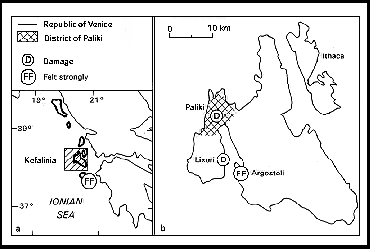
According to a local contemporary note
"earthquakes began [in Kefalinia] on the 2nd of June [1759
O.S.] and continued until the 5th; the one which happened at noon destroyed
many houses and the other on the 3rd caused the collapse of most houses in
the villages and in the town ..." (Tsitselis, 1904).
A dispatch from the Venetian authorities in Kefalinia says that
"in the night between June 13 and 14 [N.S.], at about six hours,
there was a violent earthquake which was followed by a series of weaker shocks
... The following morning, at 16 hours, there occurred a much stronger shock
... that produced great ruin ..." (ASVe, 1759a).
The damage caused by the two shocks was concentrated in the
district of Paliki and at Lixuri (ASVe, 1759b) where most of the houses,
windmills and churches collapsed and a few lives were lost.
In Argostoli the shock was strongly felt but caused no damage. The serious
situation of the country villages is stressed by the Provveditore
Generale da Mar, Francesco Grimani, in his 12 September dispatch (ASVe,
1759c).
The main shock was felt strongly in Zante (AGP, 1628-1807). There is no evidence
that the earthquake was felt at Arta and Patras (ASVe, 1728-1794; ASVe,
1712-1764). Strong aftershocks continued to be felt in Kefalinia until 5
June (Tsitselis, 1904).
1766 July (11) 22
A destructive earthquake in Kefalinia. Preceded by a foreshock
before dawn, the main shock occurred one hour after sunrise on 11 July 1766
(O.S.) lasting, with intermissions, three minutes. The earthquake was followed
by three other shocks during the same day.
The western part of Kefalinia suffered most. A manuscript note
from Michalitzata (Vergotis, 1867) says that most of the houses in the district
of Paliki were destroyed and those left standing were damaged. It adds, however,
that 52 days earlier (20 May 1766 O.S.) the south part of Paliki had suffered
from a whirlwind of unprecedented violence which did great damage. Contemporary
reports (ASVe, 1766a, b, c) confirm that the damage caused by high winds,
which persisted for 13 minutes, was enormous. The combined damage caused
by the earthquake and the wind was such that many families left Paliki and
settled in the Morea (Peloponnese). The seriousness of the situation in Kefalinia
is testified by a petition to the Collegio produced by Niccolò
Salomon, tax-farmer of that island (ASVe, 1766g): the Collegio recognized
the right of his query and asked to the Senato to approve the diminution
of his debt for the year 1766.
Earthquake damage extended to Assos (ASVe, 1766e, f), Lixuri
(ASVe, 1766b) and Argostoli where among other buildings the Latin church
of San Nicolò in Argostoli (ASVe, 1766d) and a number of manor houses
were ruined (Fig. 4). In all about 20 people were killed in the island.
The earthquake was also experienced in Zante: a European traveller who happened
to be in quarantine describes the shocks as very strong but he does not mention
any damage done in the town (Chandler, 1776). There is some evidence, however,
that the earthquake did cause the collapse of a few houses in other parts
of Zante (Tsitselis, 1904). It is said that the shock was also felt
in Ithaca (Vergotis, 1867). Aftershocks continued more
or less for 2 months (Gazette de France, 1766; ASVe, 1766b).
Some modern writers date this event to 11 May, 11 June and others place it
on 24 July (N.S.), which is the date given by the European press (Gazette
de France, 1766).
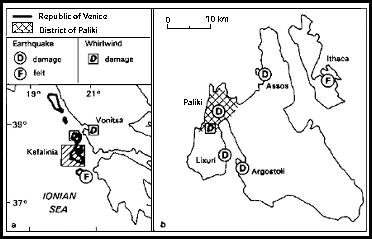
Discussion
From the foregoing we conclude that in spite of the large volume
of information retrieved for earthquakes in this part of the Mediterrranean
area, information remains insufficient for the assessment of the seismic
potential of the region. Greek sources rarely mention the effects of earthquakes
which originate in the Ionian Islands on mainland Greece unless they are
destructive in populous centres which, in this part of the country, are very
few. Even more limited in far-field information are Venetian sources which
very seldom mention an earthquake unless it caused damage to the few forts
and supply bases of the Republic in the region. This lack of information
from localities situated some distance away from the Ionian Islands makes
it difficult to quantify historical earthquakes in the region.
Acknowledgements
Part of the Venetian documents here considered (in particular
on the earthquakes of 1704, 1710, 1714, 1723, 1729, 1742, 1759 and 1766)
were retrieved in the framework of a research carried out at the State Archives
of Venice by dott. A. Daltri, to whom authors express their thanks. The research
is fully reported in Daltri e Albini (1991).
Authors would like to thank Jean Vogt, for his constant supply
of new information.
References
ACCM (Archives de la Chambre de Commerce, Marseille), 1742.
J. 520, 19 April.
AGP (Archives de la Guerre, Paris), 1628-1807. Archives
Historiques.
Albini, P. and Daltri, A., 1991. The Serenissima Republic of Venice and the
Earthquakes. In: J. Kozak (Editor), Proc. 3rd ESC Workshop on "Historical
Earthquakes in Europe", Liblice by Prague, 4-6 April 1990, pp. 98-114.
Albini, P., 1991. Datazione e prima stima degli effetti dei terremoti nelle
Isole Ionie nell'anno 1767 da documenti veneziani. In: P. Albini e M.S. Barbano
(Editors), GNDT, Atti del Convegno, Pisa, 25-27 giugno 1990, Macrosismica,
2, pp. 111-124.
Albini, P., 1993. Investigation of 17th and 18th centuries earthquakes in
the documents of governors and representatives of the Republic of Venice.
In: M. Stucchi (Editor), Materials of the CEC project "Review of Historical
Seismicity in Europe", Milano, 1, pp. 55-74.
Amato, E. d', 1715. Lettere di eruditi della Chiesa. Genova.
Ambraseys, N. and Finkel, C., 1993. Material for the Investigation of the
Seismicity of the Eastern Mediterranean Region during the period 1690-1710.
In: M. Stucchi (Editor), Materials of the CEC project "Review of Historical
Seismicity in Europe",Milano, 1, pp. 173-194.
ASVat, 1743a, b. Sacra Congregatio Concilii, Relationes, b. 891, Cefalonia:
a) cc. 248-258; b) c. 263.
ASVe (Archivio di Stato di Venezia), 1693-1722. Cinque Savi alla Mercanzia,
Lettere, Rettori, Cefalonia, b. 561.
ASVe, 1700-1746. Cinque Savi alla Mercanzia, Lettere, Rettori, Zante, b.
569.
ASVe, 1704a, b. Senato, Dispacci, Provveditori da Terra e da Mar, Provveditori
Generali da Mar, f. 951 (luglio 1702-luglio 1705): a) Dispaccio n. 85,
Provveditore Generale da Mar, Corfù, 6 dicembre; b) Disegno del fortino
di Trapano [dicembre 1704].
ASVe, 1705a, b. Senato, Decreti, Rettori, f. 145 (settembre 1704-febbraio
1705): a) Decreto al Provveditore Generale da Mar, Venezia, 17 gennaio; b)
Decreto al Provveditore Estraordinario di Santa Maura, Venezia, 22 gennaio.
ASVe, 1710. Senato, Dispacci, Provveditori da Terra e da Mar, Provveditori
Generali da Mar, f. 955 (luglio 1709-luglio 1711).
ASVe, 1712-1764. Cinque Savi alla Mercanzia, Dispacci, Consoli, Patrasso,
b. 728.
ASVe, 1714a, b. Senato, Dispacci, Provveditori da Terra e da Mar, Provveditori
Generali da Mar: a) f. 958 (dicembre 1713-settembre 1714); b) f. 959 (luglio
1714-giugno 1715).
ASVe, 1722-1723. Senato, Dispacci, Rettori, Zante, f. 29 (5 settembre
1715-15 settembre 1740).
ASVe, 1722. Senato, Dispacci, Provveditori da Terra e da Mar, Provveditori
Generali da Mar, f. 967 (1 agosto 1722-8 luglio 1723).
ASVe, 1723a. Senato, Dispacci, Provveditori da Terra e da Mar, Provveditori
Generali da Mar, f. 988 (maggio 1742-ottobre 1743): a) Terminazione del
Provveditore Generale da Mar, Zante, 24 settembre.
ASVe, 1723b, c. Senato, Dispacci, Provveditori da Terra e da Mar, Provveditori
Generali da Mar, f. 967 (1 agosto 1722-8 luglio 1723): b) Dispaccio n. 77,
Provveditore Generale da Mar, Corfù, 26 marzo; c) Dispaccio n. 83,
Provveditore Generale da Mar, Corfù, 20 aprile.
ASVe, 1724a, b, c. Senato, Dispacci, Provveditori da Terra e da Mar, Provveditori
Generali da Mar, f. 988 (maggio 1742-ottobre 1743): a) Fede giurata, [Zante],
21 giugno; b) Fede giurata, [Zante], 21 giugno; c) Estratto di decreto del
Senato al Provveditore Generale da Mar, Venezia, 25 novembre.
ASVe, 1728-1794. Cinque Savi alla Mercanzia, Dispacci, Consoli, Arta, b.
632.
ASVe, 1729a, b. Senato, Dispacci,
Rettori, Zante, f. 29 (5 settembre 1715-15 settembre 1740): a) Lettera,
Provveditore di Zante, Zante, 9 luglio; b) Lettera, Provveditore di Zante,
Zante, 4 settembre.
ASVe, 1729c, d, e. Senato, Dispacci, Provveditori da Terra e da Mar, Provveditori
Generali da Mar, f. 973 (luglio 1729-agosto 1730): c) Dispaccio n. 64,
Provveditore Generale da Mar, Corfù, 28 luglio; d) Dispaccio n. 65,
Provveditore Generale da Mar, Zante, 20 agosto; e) Perizia, Zante, 21
agosto.
ASVe, 1730. Senato, Relazioni, Zante, b. 87 (1592-1771): Relazione, Provveditore
di Zante, Venezia, 28 giugno.
ASVe, 1740. Senato, Dispacci, Provveditori da Terra e da Mar, Provveditori
Generali da Mar, f. 987 (luglio 1740-aprile 1742): Supplica, Zante, 8
ottobre.
ASVe, 1741a, b. Senato, Dispacci, Provveditori da Terra e da Mar, Provveditori
Generali da Mar, f. 987 (luglio 1740-aprile 1742): a) Dispaccio n. 49,
Provveditore Generale da Mar, Zante, 10 ottobre; b) Nota spese delle Piazze
del Levante per l'anno 1741, Corfù, 12 dicembre.
ASVe, 1742a, b, c, d. Senato, Dispacci, Provveditori da Terra e da Mar,
Provveditori Generali da Mar, f. 987 (luglio 1740-aprile 1742): a) Supplica
dei Sindici di Zante, Zante, 26 febbraio 1742; b) Lettera, Provveditore di
Zante, Zante, 27 febbraio; c) Perizia, Zante, 26 febbraio; d) Dispaccio n.
60,
Provveditore Generale da Mar, Corfù, 15 marzo.
ASVe, 1742e. Senato, Dispacci, Zante, f. 28 (1741-1753): Dispaccio, Provveditore
di Zante, Zante, 27 febbraio.
ASVe, 1742f, g, h. Senato, Dispacci, Provveditori da Terra e da Mar, Provveditori
Generali da Mar, f. 988 (maggio 1742-ottobre 1743): f) Dispaccio n. 84,
Provveditore Generale da Mar, Zante, 30 settembre; g) Dispaccio n. 86;
Provveditore Generale da Mar, Zante, 17 ottobre; h) Dispaccio n. 89,
Provveditore Generale da Mar, Cefalonia, 25 novembre.
ASVe, 1742i. Senato, Decreti, Rettori, f. 260 (marzo-giugno 1742): Decreto
al Provveditore di Zante, Venezia, 21 aprile.
ASVe, 1743. Senato, Dispacci, Provveditori da Terra e da Mar, Provveditori
Generali da Mar, f. 988 (maggio 1742-ottobre 1743): Dispaccio n. 107,
Provveditore Generale da Mar, Corfù, 8 giugno.
ASVe, 1759a, b, c. Senato, Dispacci, Provveditori da Terra e da Mar, Provveditori
Generali da Mar, f. 1002 (luglio 1759-maggio 1760): a) Lettera, Provveditore
di Cefalonia, [Cefalonia] 20 giugno 1759; b) Supplica di 41 abitanti di Palichi
[Palichi giugno 1759]; c) Dispaccio n. 61, Provveditore Generale da Mar,
Cefalonia, 12 settembre.
ASVe, 1766a, b, c, d, e, f. Senato, Dispacci, Provveditori da Terra e da
Mar, Provveditori Generali da Mar, f. 1012 (aprile 1766-febbraio 1767): a)
Dispaccio n. 86, Provveditore Generale da Mar, Corfù 20 giugno; b)
Dispaccio n. 97, Provveditore Generale da Mar, Corfù 20 novembre;
c) Supplica dei
Sindici di Cefalonia, [Cefalonia, settembre]; d) Polizza spese per il restauro
della chiesa latina di Argostoli, Cefalonia, 4 settembre; e) Lettera,
Provveditore di Asso, [Asso], 25 agosto; f) Fabbisogno per il restauro del
palazzo pubblico di Asso, Asso Fortezza, 25 agosto.
ASVe, 1766g. Collegio, Risposte di fuori, f. 512 (marzo 1766-febbraio 1767):
Risposta alla supplica di Niccolò Salamon, Venezia, 12 dicembre .
Baglivi, G., 1710. Opera omnia medico-pratica et anatomica. Lyon.
Barbiani, D.G., 1863. Mémoires sur les tremblements de terre dans
l'ile de Zante. Mémoires de l'Académie des Sciences de Dijon,
Dijon, pp. 1-112.
Chandler, 1776. Travels in Greece. Oxford.
Chiotis, P., 1849. Historika apomnimonevmata tis nisou Zakinthou. 1, Govt.
Print. Office, Kerkyra.
Chiotis, P., 1863. Seira historikon apomnimoneumatyon. 3, Govt. Print. Office.
Kerkyra.
Daltri, A. e Albini, P., 1991. L'Archivio di Stato di Venezia: studio sulla
potenzialità della documentazione ivi depositata ai fini delle ricerche
sui terremoti europei di interesse per il Progetto CEE "RHISE". Progress
Report, 120 pp.
Dudan, B., 1938. Il dominio veneziano di Levante. Bologna.
ENEL, 1986. Studi e indagini per l'accertamento della idoneità tecnica
delle aree suscettibili di insediamento di impianti nucleari. Regione Puglia,
Area costiera ionica. Indagini di sismicità storica. Rapporto finale.
Il terremoto del 20 febbraio 1743 [restricted].
Gaceta de Madrid, 1705. 3 de Março, n. 3.
Gazette de France, 1766. 19 December.
Guêze, R., 1970. Note sugli Archivi di Stato della Grecia. Roma.
Guidoboni, E., Ferrari G. e Margottini, C., 1989. Una chiave di lettura per
la sismicità antica: la ricerca dei "gemelli" del terremoto del 365
d.C. In: E. Guidoboni (Editor), I terremoti prima del Mille in Italia e nell'area
mediterrranea. Storia Archeologia Sismologia. Bologna, pp. 552-573.
Issel, A. e Agamennone, G., 1893. Cronistoria sismica di Zante. Annali
dell'Ufficio Centrale di Meteorologia e Geodinamica, XV, I.
Kouskouna, V., Makropoulos, K.C., Tsiknakis, K., 1993. Contribution of historical
information to a realistic seismicity and hazard assessment of an area. The
Ionian Islands earthquakes of 1767 and 1769: historical investigation. In:
M. Stucchi (Editor), Materials of the CEC project "Review of
Historical Seismicity in Europe", 1, Milano, pp. 195-206.
Lunzi, E., 1858. Della condizione politica delle Isole Ionie sotto il dominio
veneto. Venezia.
Machairas, K., 1951. I Lefkas epi enetokratias,1684-1797. Athens.
Margottini, C., 1985. The earthquake of February 20, 1743 in the Ionian Sea.
In: D. Postpischl
(Editor), Atlas of isoseismal maps of Italian earthquakes. Quad. Ric. Scient.
114, 2A, Bologna, pp. 62-63.
Mercati, P., 1811. Saggio storico statistico della città et isola
di Zante. Zante.
Michael, XVIII. Historia Epiri a Michaele nepote duce conscripta. In: B.G.
Niebuhr (Editor), CSHB, Bonn 1849.
Papazachos, B. and Papazachos, K., 1989. Oi seismoi tis Elladas.
Thessaloniki.
Partsch, J., 1887. Die Insel Korfu. Gotha.
Sathas, C.N., 1867. Mesaionikon seismologion tis Hellados; Cephalinia kai
Leukas. Aion, 2225.1245, Athens.
Schmidt, J.F.J., 1875. Studien über Erdbeben. Leipzig.
Shebalin, N.V., Karnik, V. and Hadzievski D. (Editors), 1974. Catalogue of
earthquakes. UNDP/UNESCO Survey of the seismicity of the Balkan Region.
Skopje.
Theatrum Europaeum, 1714. Frankfurt.
Tsiknakis, K., Makropoulos, K.C. and Kouskouna, V., 1992. Review of the Ionian
Islands historical seismicity. The Leukada earthquake of October 1st 1769.
In: A. Roca and D. Mayer-Rosa (Editors), Proc. XXII ESC General Assembly
and activity report 1988-1990, Barcelona, 17-22 September 1990, I, pp.
311-316.
Tsitselis, H., 1904. Kefalliniaka symmikta. Argostoli.
Vergotis, P., 1867. Kefallinia. Kefallinia.
Viggiano, A., 1993. Venezia e le isole del Levante. Cultura politicae incombenze
amministrative nel Dominio da Mar del XVIII secolo. Atti dell'Istituto Veneto
di Scienze Lettere ed Arti, CLI: 753-795.
Vladis, S., 1902. I Leukas; historikon dokimion. Leukas.
VVA (Vivliothiki Voulis Athinon, Athens), cod. 128.6.53.
Zois, L., 1893. Oi en Zakintho seismoi. Ai Mousai, 11, Zante.
[Top]
[Vol.1]
[Vol.2]
[Deliverables and queries]
[Presentation]
[Homepage]